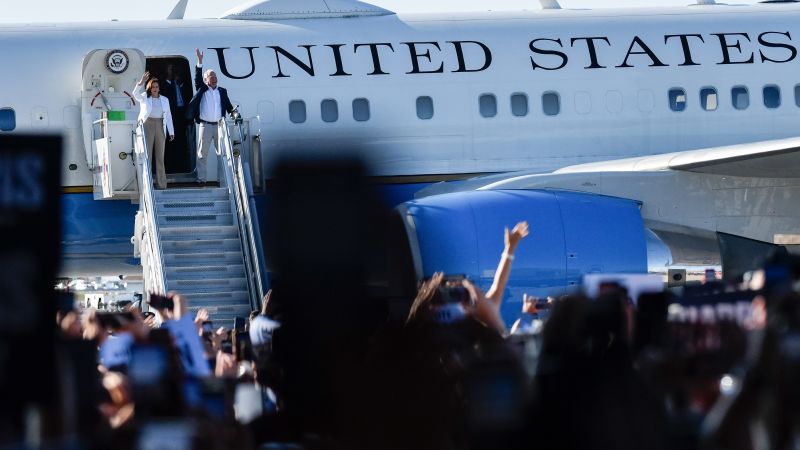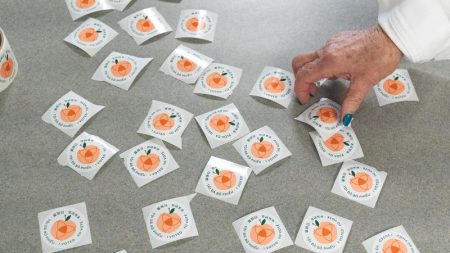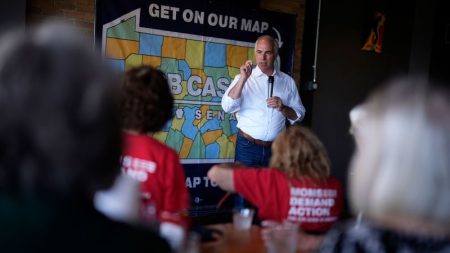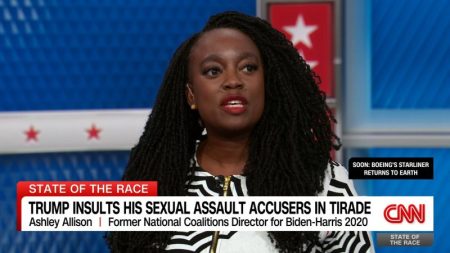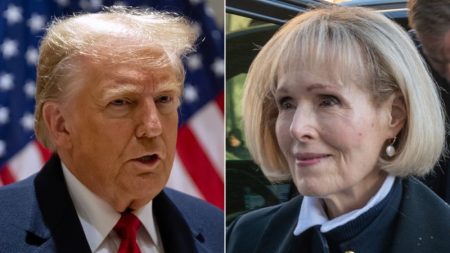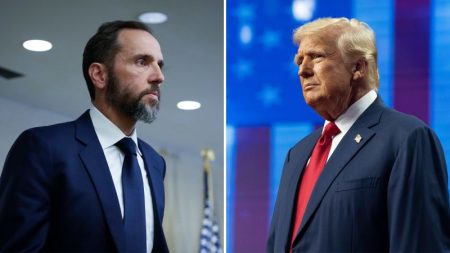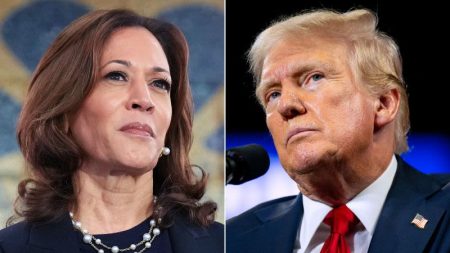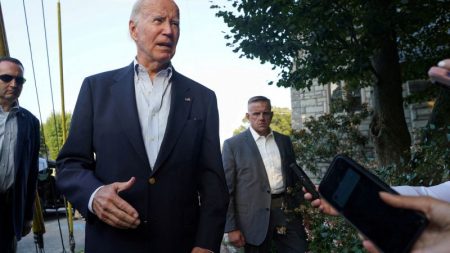Vice President Kamala Harris is capitalizing on the trappings of office — and the power of strong imagery — to sustain the momentum surrounding her candidacy in hopes of building a cultural movement for the Democratic ticket in ways that long eluded President Joe Biden.
In her quest to defeat Donald Trump, she’s also taking a page out of the former president’s own playbook — and drawing his ire in the process.
She didn’t just walk onto the stage for one of her biggest rallies of the year last week outside Detroit. Instead, her team allowed anticipation to grow as Air Force Two slowly taxied into view of a crowded airport hanger, with strains of Beyoncé’s “Run the World” pulsing through the air.
The choreography matched closely the types of events Trump held as president, his walk-out song “God Bless the USA” now replaced by another Beyoncé song, “Freedom,” as Harris stepped from her plane.
Yet for Democrats, it was a level of enthusiasm – and stagecraft – not seen for years.
“We’ve got a hot ticket,” said Danielle Tucker, a loyal Democrat, taking in the scene as she and her friends waited for Harris and running mate Tim Walz to make their entrance at the Detroit-area rally. “We’ve got a ticket that brings us joy – before it was just a lot of darkness going on.”
Deploying presidential optics is nothing new for an incumbent seeking reelection. During Trump’s first term, he held countless rallies across the country using (a slightly larger) Air Force One. The iconic blue-and-white planes, emblazoned with the words “United States of America,” convey without parallel the power of incumbency.
Even out of office, Trump has sought to harness presidential imagery to convey a sense of authority. His team refers to his private Boeing 757 as “Trump Force One.” The words “former president” are almost never used by his aides, who refer to him as 45, for his order in the line of US presidents.
Trump’s running mate, Ohio Sen. JD Vance, sought to harness a moment of executive imagery this week when he walked across a tarmac in Wisconsin to view Air Force Two up close. He told reporters he “wanted to check out my future plane” and later posted a photo of him striding away from the familiar white-and-blue jet.
As Harris seeks to become the first woman to serve as the American commander in chief, allowing voters to see her in a powerful role is a central part of the strategy to elect her to a still more powerful one.
“We’re going to do this!” Harris told a crowd Friday night in Arizona, basking in thunderous applause at the end of her weeklong run through battleground states. “We’re going to do this!”
Even before Biden’s decision to withdraw from the race, Harris had been a regular presence by his side during official events. She joined him in hosting Democratic governors at the White House and has been on the line for his phone conversations with Israeli Prime Minister Benjamin Netanyahu.
When Netanyahu was visiting Washington last month, she hosted him for a separate meeting in her office — not unusual for a visiting foreign leader. Afterward, however, she emerged to deliver her own statement to the press, backed by a row of American flags.
Harris’ team is prepared for impromptu moments to showcase her existing role in the White House. In the hours after the multicountry prisoner exchange with Russia, Harris delivered last-minute remarks on a tarmac in Houston from a lectern bearing the vice presidential seal, a stand not typically seen at the airport when the president or vice president travels.
Harris has been honing her political skills in other ways since entering the White House alongside Biden in 2021. After a somewhat rocky beginning, plagued by stories of internal dysfunction, her operation steadied. She travels frequently to promote administration priorities and meet local officials for roundtables.
The energy with which she has ascended to the Democratic nomination has impressed many in the party, who had become accustomed to watching Biden’s appearances with lingering concern about verbal or physical stumbles.

Harris’ strategy is not a particularly risky one. She has yet to sit for an interview, though she told reporters Thursday she has asked aides to put one on the schedule before the end of the month. Unlike Trump, whose speeches extend more than an hour with frequent tangents, she is a scripted presence onstage.
That has not dampened enthusiasm among her large crowds of supporters, which by the thousands have already greeted Harris in Georgia, Pennsylvania, Wisconsin, Michigan, Arizona and Nevada. In Wisconsin last week, some supporters abandoned their cars on the roadside a mile from the event site and walked the rest of the distance.
“It’s not as if anybody cares about crowd sizes or anything,” Walz quipped Friday night, praising the audience at a packed rally outside Phoenix.
Those crowds are now a pivotal part of the new plan to defeat Trump.
It’s gotten the former president’s attention.
“Oh, give me a break,” he groaned at a news conference Thursday when asked if he was worried about the size of Harris’ crowds, before launching into a lengthy answer that only underscored the attention he’s been paying to her events.
“I have 10 times, 20 times, 30 times the crowd size, and they never say the crowd was big,” he complained.
When Biden and Harris challenged Trump in 2020, the pandemic prevented large rallies, aside from toward the end of the campaign when they stood on stages far away as supporters — often by the hundreds — watched from their cars.
Over the past year, Biden struggled mightily to build crowds. Some of his official events were attended by fewer than 100 people.
A week before Biden stepped aside from the race, his campaign struggled to fill a high school gymnasium for a rally in Detroit. An urgent text message was sent to all Democratic staffers from congressional and state campaigns to help fill the seats, an aide said.
In the first weeks of her candidacy, Harris has seen a dramatic spike in interest. The campaign has utilized veteran Democratic advance staffer Greg Hale, who has helped manage the optics of several presidential campaigns and was on hand at some of Harris’ rallies over the past week.
The surge in interest has led to a rapid scaling-up of the campaign’s infrastructure. Merchandise has exploded online. Harris’s crowds are filled with supporters wearing shirts, buttons and hats of all varieties — a scene far more comparable to a Trump rally than a Biden one.
“We were all nervous about the president. We were all going to vote for him, but we were a little afraid about the opposition,” said Sheila Sigro, a beautician from Livonia, Michigan, who waited for more than seven hours to see Harris on Wednesday.
“When the big switch happened,” she added, “we saw the momentum within hours and now everyone is much, much better, with their enthusiasm and their optimism and their energy.”
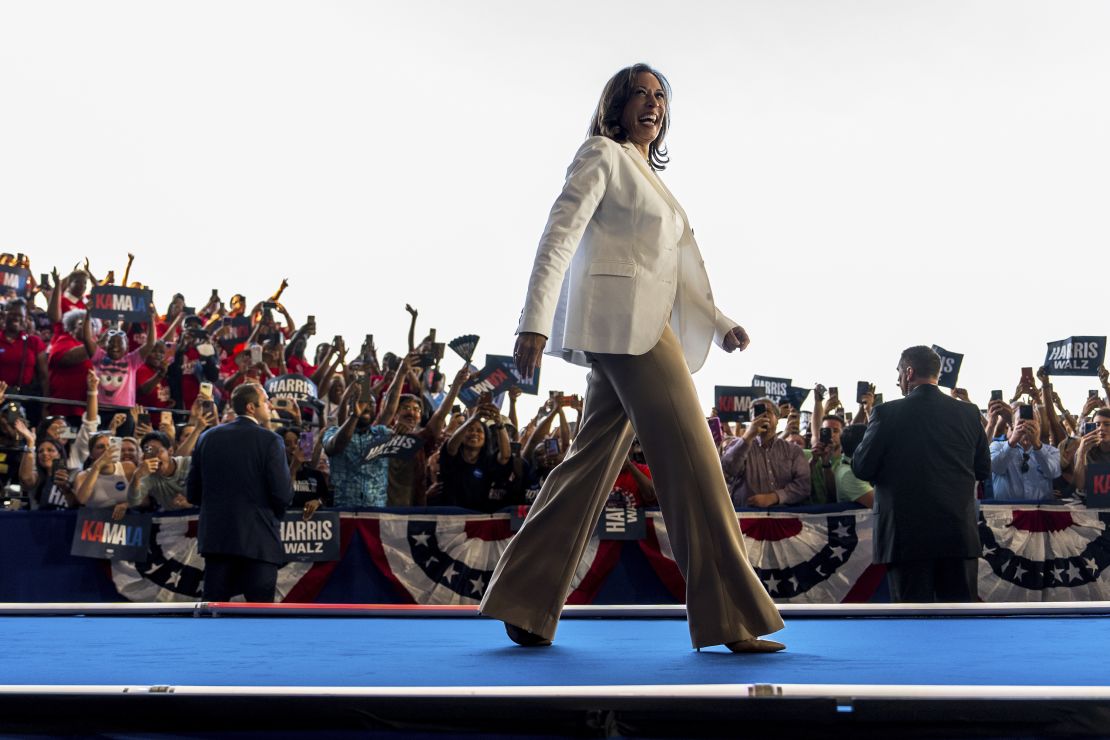
Harris’s debut as Democrats’ standard bearer has drawn comparisons to Barack Obama’s 2008 campaign, with its underpinnings of optimism and large, enthusiastic crowds. It is perhaps not a coincidence that many veterans of that effort are now working for Harris, brought into the fold shortly after Biden withdrew from the contest.
David Plouffe, who managed Obama’s first campaign, is now serving as a senior adviser in Harris’ campaign. Veterans of Obama’s 2012 reelection campaign brought onto Harris’ team include Stephanie Cutter and Mitch Stewart. They have been incorporated into a structure still helmed by Jen O’Malley Dillon, the Biden campaign chair whom Harris asked to continue in the role when she took over.
The reinforced campaign team was in place last week as Harris launched her most intensive stretch of rallies alongside her new running mate.
“I think in the last couple of weeks you’ve seen people in the Democratic Party, people in the private sector, a lot of excitement. People want to get involved and help, which is great. And I’m one of those people,” Plouffe said on CNN.
CNN’s Aaron Pellish contributed to this report.
Read the full article here
